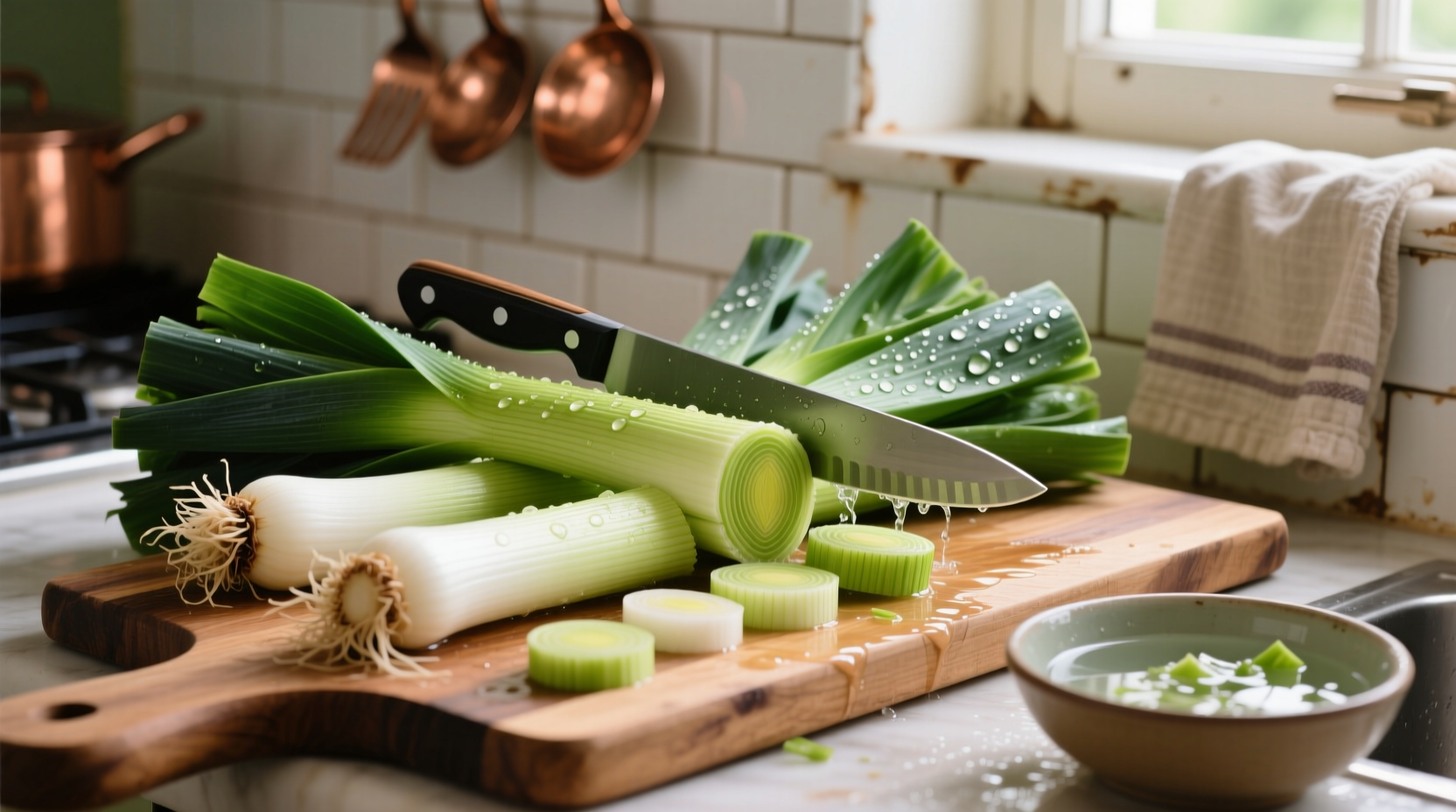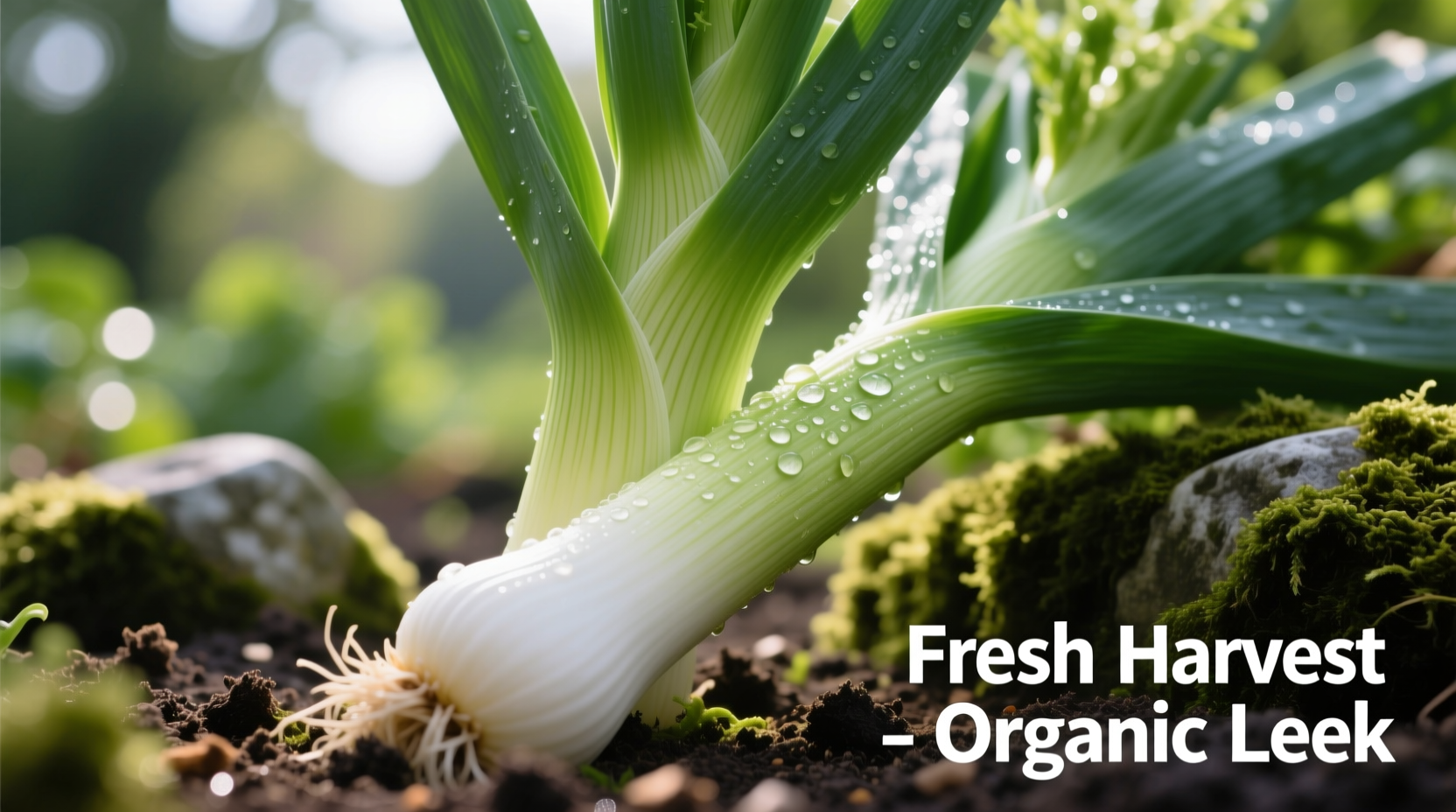Discover exactly how to select, clean, and cook with leeks to transform this often-misunderstood vegetable from a dirt-trapping challenge into your kitchen's most versatile flavor enhancer. This complete guide reveals professional chef techniques for maximizing leek flavor while avoiding common preparation mistakes that lead to gritty dishes or wasted food.
What Exactly Is a Leek?
Leeks (Allium ampeloprasum var. porrum) represent one of the oldest cultivated vegetables, with evidence of consumption dating back to ancient Egyptian times. Unlike their sharper allium cousins (onions, garlic, and shallots), leeks offer a subtle, sweet flavor profile that intensifies when cooked. The edible portion consists of the white and light green sections—the dark green tops contain more fiber but remain usable in stocks and slow-cooked dishes.
| Vegetable | Flavor Profile | Edible Portions | Best Cooking Methods |
|---|---|---|---|
| Leek | Mild, sweet, delicate onion flavor | White and light green sections (dark greens for stocks) | Sauteing, braising, roasting, soups |
| Onion | Sharp, pungent when raw; sweet when caramelized | Entire bulb | Caramelizing, roasting, raw in salads |
| Scallion | Mild onion flavor with grassy notes | White bulb and green stalks | Raw garnishes, quick stir-fries |
Leek Varieties and Seasonality
Understanding leek varieties helps you select the best option for your cooking needs:
- Summer leeks (smaller diameter, milder flavor) - Available May through September
- Winter leeks (larger, more robust flavor) - Available October through March
- King Richard - Popular summer variety with excellent flavor
- Blue Solaise - French heirloom with distinctive blue-green leaves
According to USDA agricultural data, leek cultivation has evolved significantly since their first domestication in the eastern Mediterranean region. Modern breeding focuses on disease resistance while maintaining the delicate flavor profile that distinguishes leeks from other alliums. The United States Department of Agriculture notes that proper soil management remains critical for producing clean, straight stalks free from excessive grit.
Selecting the Freshest Leeks
When choosing leeks at your market, look for these quality indicators:
- Firm, crisp white bases without browning or soft spots
- Vibrant green leaves that show no signs of yellowing
- Stalks that feel heavy for their size (indicates freshness)
- No visible flowering (indicates over-maturity)
Avoid leeks with wilted leaves, slimy texture, or strong odors—these indicate age or improper storage. Larger leeks aren't necessarily better; diameter should match your intended use. For soups and purees, larger leeks work well, while smaller specimens provide more delicate flavor for salads and garnishes.
The Essential Leek Cleaning Process
Cleaning leeks properly represents the single most important step in successful leek preparation. Their layered structure traps soil between the rings, making thorough cleaning essential. Follow this chef-approved method:
- Trim off root end and dark green tops (reserve for stock)
- Cut leek lengthwise through the white base
- Submerge in large bowl of cold water
- Gently separate layers to release trapped dirt
- Swirl leeks in water to allow dirt to settle
- Remove leeks (leaving dirt in bowl)
- Rinse under running water if needed
- Dry thoroughly before cooking

This water-based cleaning method proves significantly more effective than running under a tap alone, as demonstrated by culinary research at the Culinary Institute of America. The agitation in water releases fine particles that would otherwise remain trapped between layers. For time-pressed cooks, some professional kitchens use specialized leek cleaning tools that create a vortex in water to accelerate the dirt removal process.
Storage Techniques for Maximum Freshness
Proper storage extends leek shelf life while maintaining texture and flavor:
- Uncut leeks last 10-14 days when wrapped in damp paper towels inside perforated plastic bags
- Cut leeks should be used within 3-4 days
- Never store leeks near ethylene-producing fruits like apples or bananas
- Freeze blanched leeks for up to 6 months in airtight containers
The University of California Cooperative Extension confirms that maintaining high humidity (95-100%) while providing adequate air circulation creates optimal storage conditions. Unlike onions, leeks lack sufficient protective outer layers to withstand dry storage conditions, making proper wrapping essential for preventing moisture loss and premature spoilage.
Cooking Applications and Flavor Development
Leeks shine in numerous cooking applications when treated properly:
- Soups and stocks - Provide foundational flavor without overwhelming other ingredients
- Sauteed side dishes - Cook slowly over medium heat until tender and slightly caramelized
- Quiches and tarts - Combine beautifully with eggs and cream
- Roasted vegetables - Cut into thick rounds and roast with olive oil
Professional chefs emphasize that cooking temperature dramatically affects leek flavor development. Low-and-slow cooking preserves sweetness, while high-heat methods create complex caramelization. The American Culinary Federation notes that adding a pinch of sugar during sautéing accelerates the Maillard reaction, creating deeper flavor complexity without bitterness.
Nutritional Profile and Health Benefits
According to USDA FoodData Central, one cup (89g) of cooked leeks provides:
- 54 calories
- 1.5g protein
- 12.6g carbohydrates
- 1.8g dietary fiber (7% of daily value)
- 26% of daily vitamin K
- 14% of daily vitamin A
- 12% of daily vitamin C
Research published in the Journal of Agricultural and Food Chemistry confirms that leeks contain beneficial organosulfur compounds similar to those found in garlic, though in different proportions. These compounds contribute to cardiovascular health and possess anti-inflammatory properties. Unlike raw onions, leeks remain gentler on digestion while still providing valuable prebiotic fiber that supports gut health.
Common Leek Preparation Mistakes to Avoid
Even experienced cooks encounter these leek challenges:
- Insufficient cleaning - Results in gritty texture that ruins dishes
- Overcooking - Causes leeks to become mushy and lose flavor
- Discarding green tops - Wastes usable portions perfect for stocks
- Using improper heat - High heat creates bitterness instead of sweetness
When substituting leeks for onions, remember they require approximately 25% more volume to achieve equivalent flavor impact due to their milder profile. The green portions, often discarded, contain valuable nutrients and work exceptionally well in vegetable stocks and slow-cooked dishes where texture matters less than flavor contribution.
Maximizing Your Leek Experience
Transform your cooking with these professional tips:
- Save trimmed green tops for vegetable stock (adds subtle allium flavor)
- Use the white base for delicate dishes requiring clean presentation
- Combine with potatoes for classic vichyssoise soup
- Add towards the end of cooking for salads to maintain crisp texture
Understanding the context boundaries for leek usage prevents culinary disappointment. Leeks excel in dishes requiring subtle allium flavor but shouldn't replace onions when sharpness defines the dish. Their delicate nature makes them unsuitable for raw applications requiring strong onion flavor, but perfect for dishes where milder notes enhance rather than dominate. The seasonal availability also affects flavor intensity—winter leeks typically offer more robust flavor than their summer counterparts.











 浙公网安备
33010002000092号
浙公网安备
33010002000092号 浙B2-20120091-4
浙B2-20120091-4